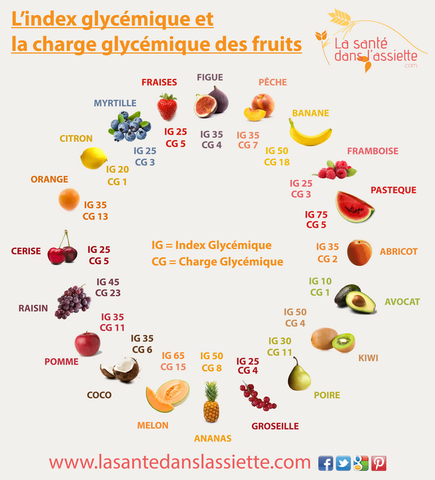It was important for us to answer this question that many of you who are starting a low GI diet are asking. Since fruits are sweet, what should I watch out for?
To begin with, fruits can definitely be included in a low glycemic index diet. In fact, many fruits have a low or moderate GI. The important thing is to choose the right types of fruit and consume them in moderation, taking into account their sugar and fiber content.
Here are some tips for selecting your fruits:
👉 GI and fruit maturity
Opt for fruits with a low or moderate glycemic index. Soft fruits (raspberries, strawberries, blueberries), apples, pears, peaches, plums, citrus fruits and cherries are generally good low-glycemic options. Be careful, the riper a fruit, the sweeter it will be and will have a higher GI! Find the GI of fruits at the bottom of the article (source Health on the plate)
👉 Fiber content
Fruits rich in fiber are particularly beneficial in a low GI diet. Fiber slows the digestion of carbohydrates and helps prevent blood sugar spikes. Look for fruits with edible skin, as most of the fiber is found in the skin. Also, eat your fruits whole and not processed into smoothies or fruit juices so as not to destroy the fiber.
👉 Portion size
Even though low GI fruits have less impact on blood sugar, it is still important to watch portion sizes. Eating a large amount of fruit can lead to an increase in carbohydrate and sugar consumption, which could still affect your blood sugar levels.
👉 Combination with other foods
When you eat fruit, don't hesitate to combine this snack with a source of protein, good fat or fiber to further slow the absorption of carbohydrates and stabilize your blood sugar. For example, combine berries with natural yogurt and nuts.
👉 Time of consumption
Avoid consuming a large quantity of fruit at a time of day when your physical activity will be low.
Times when you are more active are generally better to eat carbs because your body can better use them for energy.
👉 Personal monitoring
Each individual reacts differently to foods depending on their metabolism or, for example, their type of diabetes. It is therefore advisable to monitor your blood sugar levels after consuming different types of fruits to determine how they affect you personally.
In summary, fruit can definitely be part of a low-glycemic diet, as long as you choose the right varieties, watch portions and combine them wisely with other foods. Fruits are a valuable source of vitamins, minerals, fiber and antioxidants, making them beneficial to your health when consumed in a balanced way!
Discover the glycemic indices of the main fruits right here:










